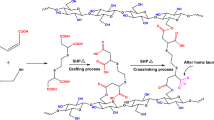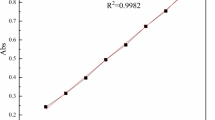Abstract
In this study, a ‘green’ crosslinker was developed using sucrose, an inexpensive natural resource, as replacement for conventional durable-press finishing agents for cotton fabrics. Sucrose was oxidized using a benign oxidizing agent, hydrogen peroxide (H2O2), and carboxylated using malic acid to form multifunctional sucrose acid (MSA). Changes in chemical structure and presence of multiple carboxylic acid groups after oxidation and carboxylation were confirmed using both ATR-FTIR and 13C NMR. Cotton fabrics treated with MSA showed a maximum wrinkle recovery angle (WRA) of 202°, over 77% improvement compared to 114° for untreated fabrics. More importantly, the chemical crosslinks introduced in the fabrics after MSA treatment as confirmed by ATR-FTIR were found durable to multiple laundry washings. MSA treated fabrics showed only 18% loss in tensile strength in the warp direction and SEM images of the treated fibers did not show any surface change. This suggested that MSA could be used to replace currently used dimethyloldihydroxyethyleneurea or 1,2,3,4-butanetetracarboxylic acid based finishing agents which are toxic and expensive, respectively. The crosslinking mechanism using MSA and the changes in the physical properties of the fabrics such as WRA, color and tensile strength and strain are discussed.
Graphic abstract









Similar content being viewed by others
References
Bao L-H, Yun-Jun L (2018) Silicone softener for stain repellent stain release and wrinkle resistance fabric finishing. J Eng Fiber Fabr 13:155892501801300301
Dastidar TG, Netravali AN (2013) A soy flour based thermoset resin without the use of any external crosslinker. Green Chem 15:3243–3251
Dehabadi VA, Buschmann H-J, Gutmann JS (2012) Durable press finishing of cotton fabrics with polyamino carboxylic acids. Carbohydr Polym 89:558–563
Dehabadi VA, Buschmann H-J, Gutmann JS (2013) Durable press finishing of cotton fabrics: an overview. Text Res J 83:1974–1995
Edye LA, Meehan GV, Richards GN (1994) Influence of temperature and pH on the platinum catalysed oxidation of sucrose. J Carbohydr Chem 13:273–283
Hashem M, Ibrahim NA, El-Shafei A, Refaie R, Hauser P (2009) An eco-friendly–novel approach for attaining wrinkle–free/soft-hand cotton fabric. Carbohydr Polym 78:690–703
Ibrahim NA, Aly AA, Eid BM, Fahmy HM (2018) Green approach for multifunctionalization of cellulose-containing fabrics. Fiber Polym 19:2298–2306
Jalaja K, James NR (2015) Electrospun gelatin nanofibers: a facile cross-linking approach using oxidized sucrose. Int J Biol Macromol 73:270–278
Ji B, Yan K, Sun G (2016a) Investigation on functional properties of 1, 2, 3, 4-butanetetracarboxylic acid cross-linked fabrics impacted by molecular structures and chemical affinity of catalysts. Ind Eng Chem Res 55:5216–5222
Ji B, Zhao C, Yan K, Sun G (2016b) Effects of acid diffusibility and affinity to cellulose on strength loss of polycarboxylic acid crosslinked fabrics. Carbohydr Polym 144:282–288
Kim B-H, Jang J, Ko S-W (2000) Durable press finish of cotton fabric using malic acid as a crosslinker. Fiber Polym 1:116–121
Lam Y, Kan C, Yuen C (2011) Physical and chemical analysis of plasma-treated cotton fabric subjected to wrinkle-resistant finishing. Cellulose 18:493–503
Lao L, Fu L, Qi G, Giannelis EP, Fan J (2017) Superhydrophilic wrinkle-free cotton fabrics via plasma and nanofluid treatment. ACS Appl Mater Interfaces 9:38109–38116
Lemoine S, Thomazeau C, Joannard D, Trombotto S, Descotes G, Bouchu A, Queneau Y (2000) Sucrose tricarboxylate by sonocatalysed TEMPO-mediated oxidation. Carbohydr Res 326:176–184
Liu J, Wang B, Xu X, Chen J, Chen L, Yang Y (2016) Green finishing of cotton fabrics using a xylitol-extended citric acid cross-linking system on a pilot scale. ACS Sustain Chem Eng 4:1131–1138
Luo X, Shao D, Xu C, Wang Q, Gao W (2019) An eco-friendly way to whiten yellowish anti-wrinkle cotton fabrics using TBCC-activated peroxide low-temperature post-bleaching. Cellulose 26:3575–3588
Mallat T, Baiker A (1994) Oxidation of alcohols with molecular oxygen on platinum metal catalysts in aqueous solutions. Catal Today 19:247–283
Max J-J, Chapados C (2002) Infrared spectroscopy of aqueous carboxylic acids: malic acid. J Phys Chem A 106:6452–6461
Mwaikambo LY, Bisanda ETN (1999) The performance of cotton–kapok fabric–polyester composites. Polym Test 18:181–198
Panda PK, Jassal M, Agrawal AK (2016) In situ atmospheric pressure plasma treatment of cotton with monocarboxylic acids to impart crease-resistant functionality. Cellulose 23:993–1002
Parpot P, Kokoh K, Belgsir E, Le J-M, Beden B, Lamy C (1997) Electrocatalytic oxidation of sucrose: analysis of the reaction products. J Appl Electrochem 27:25–33
Patil NV, Netravali AN (2016) Microfibrillated cellulose-reinforced nonedible starch-based thermoset biocomposites. J Appl Polym Sci 133:43803
Patil NV, Netravali AN (2019a) Cyclodextrin-based “green” wrinkle-free finishing of cotton fabrics. Ind Eng Chem Res. https://doi.org/10.1021/acs.iecr.9b04092
Patil NV, Netravali AN (2019b) enhancing strength of wool fiber using a soy flour sugar-based “green” cross-linker. ACS Omega 4:5392–5401
Qi H, Huang Y, Ji B, Sun G, Qing F-l, Hu C, Yan K (2016) Anti-crease finishing of cotton fabrics based on crosslinking of cellulose with acryloyl malic acid. Carbohydr Polym 135:86–93
Schramm C, Rinderer B (2015) Non-formaldehyde, crease-resistant modification of cellulosic material by means of an organotrialkoxysilane and metal alkoxides. Cellulose 22:2811–2824
Wang Y et al (2017) Effect of anti-creasing component on properties of two-ply cotton yarn. Cellulose 24:3073–3082
Welch CM, Peters JG (1997) Malic acid as a nonformaldehyde DP finishing agent activated by BTCA and polymer additives. Text Chem Color 29:33–37
Xu W, Li Y (2000) Cotton fabric strength loss from treatment with polycarboxylic acids for durable press performance. Text Res J 70:957–961
Xu H, Liu P, Mi X, Xu L, Yang Y (2015) Potent and regularizable crosslinking of ultrafine fibrous protein scaffolds for tissue engineering using a cytocompatible disaccharide derivative. J Mater Chem B 3:3609–3616
Yang CQ (1991) FT-IR spectroscopy study of the ester crosslinking mechanism of cotton cellulose. Text Res J 61:433–440
Yang CQ, Wang X (1997) Infrared spectroscopy studies of the cyclic anhydride as the intermediate for the ester crosslinking of cotton cellulose by polycarboxylic acids. III. Molecular weight of a crosslinking agent. J Polym Sci, Part A: Polym Chem 35:557–564
Yang CQ, Wang X, Kang I-S (1997) Ester crosslinking of cotton fabric by polymeric carboxylic acids and citric acid. Text Res J 67:334–342
Yang CQ, Xu L, Li S, Jiang Y (1998) Nonformaldehyde durable press finishing of cotton fabrics by combining citric acid with polymers of maleic acid. Text Res J 68:457–464
Yao W, Wang B, Ye T, Yang Y (2013) Durable press finishing of cotton fabrics with citric acid: enhancement of whiteness and wrinkle recovery by polyol extenders. Ind Eng Chem Res 52:16118–16127
Zhang SD, Zhang YR, Wang XL, Wang YZ (2009) High carbonyl content oxidized starch prepared by hydrogen peroxide and its thermoplastic application. Starch-Stärke 61:646–655
Zhang X, Yang Y, Yao J, Shao Z, Chen X (2014) Strong collagen hydrogels by oxidized dextran modification. ACS Sustain Chem Eng 2:1318–1324
Acknowledgments
This work made use of the Cornell University NMR Facility, which is supported, in part, by the NSF through MRI award CHE-1531632.
Author information
Authors and Affiliations
Corresponding author
Additional information
Publisher's Note
Springer Nature remains neutral with regard to jurisdictional claims in published maps and institutional affiliations.
Rights and permissions
About this article
Cite this article
Patil, N.V., Netravali, A.N. Multifunctional sucrose acid as a ‘green’ crosslinker for wrinkle-free cotton fabrics. Cellulose 27, 5407–5420 (2020). https://doi.org/10.1007/s10570-020-03130-9
Received:
Accepted:
Published:
Issue Date:
DOI: https://doi.org/10.1007/s10570-020-03130-9




